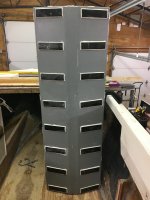76SeaRay
Lieutenant Junior Grade
- Joined
- Aug 24, 2017
- Messages
- 1,071
My original tank from 1976 was foamed into place and had corrosion (aluminum). I ordered a new tank (60 gallon) made using the dimensions of the old tank to get an exact replacement. I thought pretty simple, yeah right. I finally got all the neoprene pads in place on the new tank and have it sitting in place for a final test fit. Then, I had a thought, how do I know if the neoprene pads on the bottom are actually sitting on the hull? I got out my inspection scope and put the probe in through the bulkhead drain holes at the bottom. Sure enough it appears that the pads on the tank bottom are not sitting on the hull to distribute the load. The angle of the original tank bottom did not match the hull shape which apparently didn't matter since the original tank was foamed in place.
It looks like the V of the hull is steeper than the angle of the tank bottom. I picked up some modeling clay to put on the pads to see how much of a gap I have on each pad by squeezing the clay down as the tank sits on top of them. Then I have to figure out how to build up the pads or hull with "wedges" to get even distribution of weight on the hull.
Lesson learned, I should have double checked the tank bottom shape and the hull shape before ordering a replacement tank instead of assuming that they matched from the factory.
It looks like the V of the hull is steeper than the angle of the tank bottom. I picked up some modeling clay to put on the pads to see how much of a gap I have on each pad by squeezing the clay down as the tank sits on top of them. Then I have to figure out how to build up the pads or hull with "wedges" to get even distribution of weight on the hull.
Lesson learned, I should have double checked the tank bottom shape and the hull shape before ordering a replacement tank instead of assuming that they matched from the factory.























